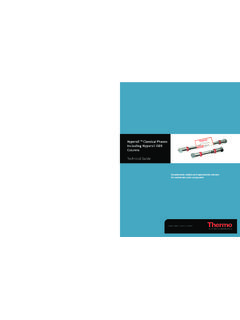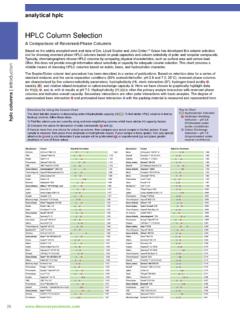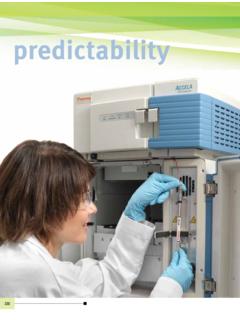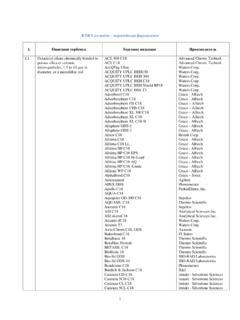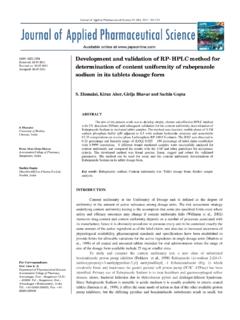Transcription of 1 Purity Analysis and Impurities Determination by …
1 11 Purity Analysis and Impurities Determination by Reversed-Phase High-Performance Liquid ChromatographyHagen Cramer, Kevin J. Finn, and Eric HerzbergGirindus America, , IntroductIonThe increasing significance of oligonucleotides as therapeutic agents necessitates a high level of quality control. In such protocols, chromatographic Analysis of crude and final active pharmaceu-tical ingredients (API) is necessary to ensure the detection of contaminants at concentration lev-els down to trace amounts relative to the drug. A combination of chromatographic techniques, in particular reverse-phased high-performance liquid chromatography (RP-HPLC), anion-exchange (AEX) HPLC (Chapter 2), and mass spectrometry (Chapters 4 and 5), is needed for the identification and structural elucidation of by-products and degradation products resulting from the production Introduction.
2 Historical Aspects .. Reverse-Phased High-Performance Liquid Chromatography Stationary Phases .. Mobile Phases .. Retention Time and Separation Selectivity Prediction Models .. Selected Practical Examples of IP-HPLC .. Column Influence on Chromatography .. Mobile Phase Influence on Chromatography .. HPLC versus UPLC .. Temperature Influences of Chromatography .. Sample Preparation .. Salt Effects .. Addition of Buffer .. Concentration and Injection Volume .. Analysis of Oligonucleotides Containing Phosphorothioate versus Phosphate Backbones .. Denaturing versus Nondenaturing Ion-Pairing Methods .. Summary ..41 Acknowledgments ..42 References .. 111/15/2010 6:28:54 PM2 Handbook of Analysis of Oligonucleotides and Related Productsprocess.
3 In clinical studies employing oligonucleotides, high sensitivity and low sample requirement for analytical methods are requisite for the identification of metabolites (Chapter 8). HIstorIcal aspectsReversed-phase HPLC (RP-HPLC) is one of the most important techniques for the characteriza-tion of oligonucleotides. Over the years, the ability to resolve Impurities from the main product peak has increased dramatically by introduction of smaller chromatographic particle sizes. Another advantage of RP-HPLC is that mobile phases that work well for separating Impurities and at the same time are compatible with electrospray ionization mass spectrometry (ESI-MS) are available (see Chapter 4).Just 10 15 years ago, the typical particle size used for analytical reversed-phase columns was 5 m.
4 To achieve good separations on 5 m particle-size columns, fairly long columns were needed (up to 250 mm), resulting in long run times. Typically, these columns had a diameter of mm. In the late nineties, the first columns with m particle size useful for oligonucleotide Analysis came to market. With the smaller particle-size beads, it now was possible to achieve better separations with shorter columns, reducing typical column length to 50 mm (up to 150 mm maximum). This resulted in shorter run times as well. In addition, more accurate HPLC pumps allowed reduction of the column diameter to mm, thereby further decreasing buffer consumption. Modern HPLC systems could also tolerate the attendant increased pressure associated with media having smaller particle , even smaller particle sizes were introduced with the smallest ones useful for oligo-nucleotide Analysis being m.
5 Particle sizes of below m, while useful for small molecule analytes, result in degradation of the oligonucleotide during Analysis owing to the increased shear-ing forces present at these high back pressures. As it is, m particle-size sorbents generate back pressures of over 400 bar (ca. 6000 psi), making them incompatible with traditional HPLC systems. To achieve similar column plates without increasing back pressures, fused-core (also called core-shell) particle technology was introduced by Joseph J. Kirkland in 20071,2 based on his earlier work with poroshell ,4 Thereby, the all-porous particle typically used is replaced with a nonporous core surrounded by a porous polystyrene-based columns have proven successful on the preparative scale owing to their increased chemical stability, the analytical reversed-phase HPLC market is dominated by silica gel or silica-based resins.
6 Reverse-pHased HIgH-performance lIquId cHromatograpHy columnsThere are multiple companies that offer reversed-phase HPLC columns. Table lists commer-cially available silica-based reversed-phase HPLC columns. Columns most widely used in oligo-nucleotide separations are available from Agilent (Zorbax), Phenomenex (Clarity), and Waters (X-Terra , X-Bridge , Acquity BEH).Typical particle sizes for columns from all manufacturers used to be 5 m for many years until about 10 15 years ago. In the mid to late 1990s, smaller particle-size columns were introduced and recently sub-2 m particles have started gaining in popularity. However, not all column manufac-turers made the switch to sub-2 m particle-size resins.
7 The use of sub-2 m particle sizes allows the use of much shorter columns without losing separation power because theoretical plates can be ,6 A reduction of the particle diameter by 50% results approximately in a doubling of the plate count. Therefore, fast and efficient separations can be achieved because separation time is proportional to column length. A shorter column run at the same velocity as a longer column also uses less solvent. However, the small particle sizes result in high back pressure a traditional HPLC system cannot withstand. New ultra-high pressure systems had to be developed. These new systems are called U-HPLCs or UPLCs and at this time only a handful of companies are offering 211/15/2010 6:28:54 PMPurity Analysis and Impurities Determination 3such systems, which are listed in Table Systems are being improved continuously because requirements on components due to the increased pressure are much more rigorous in comparison to traditional HPLC bead chemistry has traditionally been the state of the art because of its good mechanical strength, spherical shape and high chromatographic efficiency, and compatibility with a host of organic solvents.
8 Two chief problems associated with the use of silica-based cores are resolu-tion of basic analytes and stability of the bonded phase toward low- and particularly high-pH mobile phases. Several modifications to the silica-bonded phase have been implemented in order to address these issues,7 including incorporation of polar functional groups,8 sterically hindered silanes, biden-tate, or hybrid organic inorganic stationary XTerra column, first introduced in 1999 by Waters (Milford, MA), uses patented hybrid particle technology (HPT) to overcome traditional silica s instability to high pH. The core bead is composed of a methylpolyethoxysilane (MPEOS) monomer synthesized by condensation of tetraethoxysilane (TEOS) and methyltriethoxysilane (MTEOS).
9 XTerra s stationary phase demonstrates equivalent efficiency to state of the art silica-based C18 columns while addressing the problem of pH instability. Hybrid particle technology, so named because it combines inorganic (silica) with organic (polymeric) bead chemistry, describes the replacement of one of every three silyl groups with a methyl group. taBle column manufacturersmanufacturerBrand namesub-2 m particlesAdvanced Chromatography TechnologiesACENo (3 m minimum)AgilentZorbax Eclipse Plus & ExtendYesAzko-NobelKromasilNo ( m minimum)BischoffProntoPEARLYesGrace/Allt echAlltime, Vydac, VisionHTYesBeckman-CoulterUltrasphere ODSNo (5 m minimum)EMD/MerckLiChrospherNo (5 m minimum)GL SciencesIntersilNo (2 m minimum)InterchimUptisphereNo (5 m minimum)Macherey-NagelNucleosil, NucleodurYesPhenomenexGemini, Luna & ClarityNo (3 m minimum)ResekAllure, Ultra, PinnacleYesSepaxGP seriesYesShimadzu/ShantPathfinderYesSupe lcoAscentisNo (3 m minimum)
10 ThermoHypersil GoldYesWatersX-Terra, X-Bridge & Acquity BEHYesYMCS everalYestaBle systemsmanufacturername of systempressure limit, BarAgilent1200 Series1290 Infinity LC6001200 HitachiLaChrom ULTRA 311/15/2010 6:28:54 PM4 Handbook of Analysis of Oligonucleotides and Related ProductsThe substitution of the methyl for the more polar silanol dramatically increases the hydrophobicity of the core structure of the particle backbone. The introduction of the hybrid particle offers increased robustness and improved resolution of basic compounds. In 2005, Waters launched a second genera-tion hybrid column called XBridge with bridged ethyl hybrid (BEH) technology. The polyethoxysi-lane core marketed as BEH technology relies on cross-linking TEOS with bis(triethoxysilyl)ethane (BTEE).
